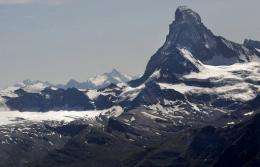A view of the Swiss Alps at Matterhorn. A surge in sunshine more than 60 years ago helped Swiss mountain glaciers melt faster than today, even though warmer average temperatures are being recorded now, Swiss researchers said Monday.
A surge in sunshine more than 60 years ago helped Swiss mountain glaciers melt faster than today, even though warmer average temperatures are being recorded now, Swiss researchers said Monday.
Their study into the impact of solar radiation on Alpine glaciers made the "surprising discovery" that in the 1940s, and especially summer 1947, the ice floes lost the most ice since measurements begin 95 years ago, according to Zurich's Federal Institute of Technology (ETHZ).
Yet, average temperatures have been rising in the past two decades and scientists have said glacier melt is accelerating at unprecedented levels under the impact of climate change.
"The surprising thing is that this paradox can be explained relatively easily with radiation," said one the ETHZ researchers, Matthias Huss, in the university's online review.
"This should not lead people to conclude that the current period of global warming is not really as big of a problem for the glaciers as previously assumed," he added.
The researchers found from historic data on three Swiss glaciers, as well as radiation recordings from the eastern Alpine town of Davos, that the level of sunshine in the 1940s was eight percent higher than average and significantly higher than now.
As a result, snow and ice melted by about four percent.
A phase of less sunshine -- global dimming -- from the 1950s to 1980s also corresponded with the advance in the snout of glaciers.
However, the ETHZ scientists said they also found that "temperature-based opposing mechanisms" came into play about 30 years ago and have been sustained.
The study published in the peer reviewed journal "Geophysical Research Letters" is part of broader reseach into the impact of climate change on the Alps and the role of solar radiation in climate models.
Studies have shown that solar radiation can vary substantially due to cloud cover and aerosols -- particles and gases -- in the atmosphere.
(c) 2009 AFP



















